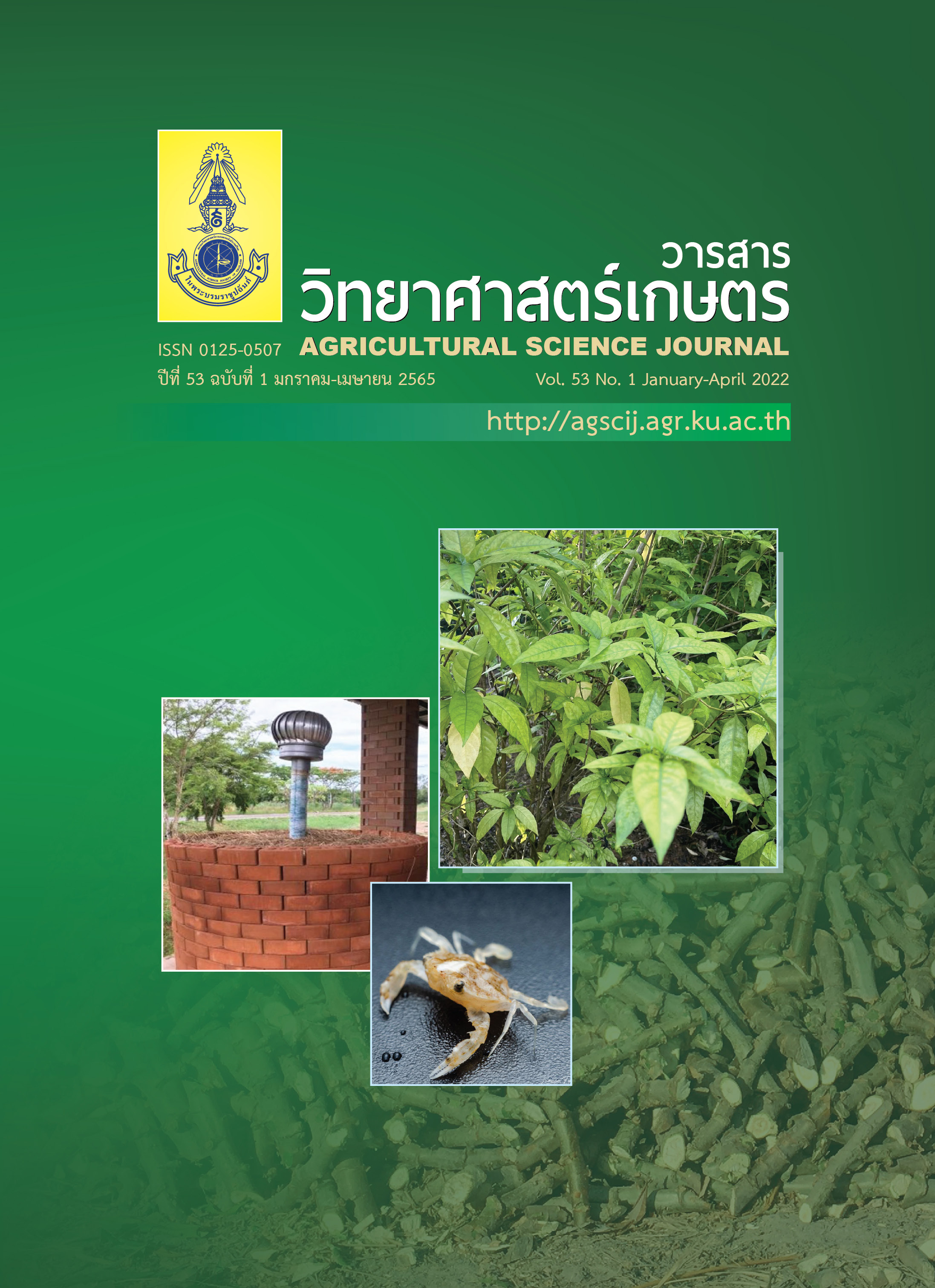การตอบสนองของปากใบและกระบวนการสังเคราะห์แสงภายใต้สภาวะเครียดจากเกลือที่ชักนำด้วยโซเดียมคลอไรด์ของข้าวพันธุ์ขาวดอกมะลิ 105 ในระยะแตกกอ
Main Article Content
บทคัดย่อ
งานวิจัยนี้มีวัตถุประสงค์เพื่อศึกษาการตอบสนองของปากใบ การตรึงคาร์บอนไดออกไซด์ และปฏิกิริยาจากแสงของข้าวขาวดอกมะลิ 105 (KDML105) ในระยะแตกกอภายใต้สภาวะเครียดจากเกลือที่ชักนำด้วยโซเดียมคลอไรด์ (NaCl) โดยปลูกต้นข้าวในสารละลายสูตร 1/2 Yoshida จนต้นข้าวมีอายุ 55 วัน (ระยะแตกกอ) จึงย้ายลงปลูกในสารละลายธาตุอาหารที่ชักนำให้เกิดสภาวะเครียดจากเกลือด้วยการเติม NaCl ที่ความเข้มข้น 3 ระดับคือ 0 (กลุ่มควบคุม) 60 (ความเครียดระดับต่ำ) และ 120 (ความเครียดระดับรุนแรง) มิลลิโมลาร์ เป็นเวลา 28 วัน วัดเส้นตอบสนองต่อแสง ประสิทธิภาพการใช้แสงสูงสุดของระบบแสงสอง ปริมาณรงควัตถุในใบ และความเข้มข้นของธาตุอาหารที่ปรากฏในใบข้าว พบว่า สภาวะเครียดจากเกลือที่รุนแรงเพิ่มขึ้นชักนำให้ค่าการชักนำการเปิดปิดปากใบ (gs) ลดลงอย่างชัดเจน และส่งผลต่อเนื่องให้ค่าอัตราการสังเคราะห์แสงสุทธิและอัตราการคายน้ำลดลง ปากใบของข้าวภายใต้สภาวะเครียดจากเกลือที่ระดับต่ำเปิดเพิ่มขึ้นในช่วงระดับความเข้มแสงที่ 0–800 µmol PPF m-2 s-1 และไม่สามารถเปิดกว้างขึ้นได้อีกตามความเข้มแสงที่เพิ่มขึ้น และเมื่อสภาวะเครียดจากเกลือเข้าสู่ระดับรุนแรงสูงสุด พบว่า ปากใบเปิดเพิ่มขึ้นตามความเข้มแสงในช่วงแคบกว่าระหว่าง 0–600 µmol PPF m-2 s-1 แต่ไม่สามารถเปิดกว้างขึ้นที่ระดับความเข้มแสงที่สูงกว่านี้ และปิดแคบลงเมื่อความเข้มแสงสูงเกิน 2,000 µmol PPF m-2 s-1 นอกจากนี้ ต้นข้าวที่อยู่ภายใต้สภาวะเครียดจากเกลือที่ระดับรุนแรงมีประสิทธิภาพการตรึงคาร์บอนไดออกไซด์และประสิทธิภาพการใช้แสงลดลง แต่สภาวะเครียดจากเกลือทั้งสองระดับไม่ส่งผลกระทบต่อระบบรับแสงของใบข้าว โดยค่าประสิทธิภาพการใช้แสงสูงสุดของระบบแสงสองและปริมาณรงควัตถุของใบข้าวยังอยู่ในระดับปรกติ นอกจากนี้ ใบข้าวที่ได้รับสภาวะเครียดจากเกลือยังมีความเข้มข้นของโซเดียมที่ปรากฏในใบสูงขึ้น และสัดส่วนความเข้มข้นระหว่างโพแทสเซียมและโซเดียมลดลงด้วย พารามิเตอร์ที่ใช้เป็นดัชนีระบุความรุนแรงของสภาวะเครียดจากเกลือได้ คือ ค่าการชักนำการเปิดปิดปากใบ ค่าประสิทธิภาพการตรึงคาร์บอนไดออกไซด์ชั่วขณะ (Pn/Ci) อัตราการเคลื่อนย้ายอิเล็กตรอน (ETR) และสัดส่วนของอัตราการเคลื่อนย้ายอิเล็กตรอนต่ออัตราการสังเคราะห์แสงสุทธิ (ETR/Pn)
Article Details

อนุญาตภายใต้เงื่อนไข Creative Commons Attribution-NonCommercial-NoDerivatives 4.0 International License.
เอกสารอ้างอิง
Arnon, D.I. 1949. Copper enzymes in isolated chloroplasts. Polyphenol oxidase in Beta vulgaris. Plant Physiol. 24(1): 1–15.
Baker, N.R., J. Harbinson and D.M. Kramer. 2007. Determining the limitations and regulation of photosynthetic energy transduction in leaves. Plant Cell Environ. 30(9): 1107–1125.
Björkman, O. and B. Demmig. 1987. Photon yield of O2 evolution and chlorophyll fluorescence characteristics at 77 K among vascular plants of diverse origins. Planta. 170(4): 489–504.
Bose, J., R. Munns, S. Shabala, M. Gilliham, B. Pogson and S.D. Tyerman. 2017. Chloroplast function and ion regulation in plants growing on saline soils: lessons from halophytes. J. Exp. Bot. 68(12): 3129–3143.
Chanchareonsook, J. 1993. Chemical Analysis of Soil and Plant Materials. Department of Soil Science, Faculty of Agriculture, Kasetsart University, Bangkok, Thailand. 213 pp. (in Thai)
Chaves, M.M., J. Flexas and C. Pinheiro. 2009. Photosynthesis under drought and salt stress: regulation mechanisms from whole plant to cell. Ann. Bot. 103(4): 551–560.
Department of Soil Science. 2005. Introduction to Soil Science. Faculty of Agriculture, Kasetsart University, Bangkok, Thailand. 547 pp. (in Thai)
Goh, C.H., S.M. Ko, S. Koh, Y.J. Kim and H.J. Bae. 2012. Photosynthesis and environments: photoinhibition and repair mechanisms in plants. J. Plant Biol. 55(2): 93–101.
Guo, H., Z. Huang, M. Li and Z. Hou. 2020. Growth, ionic homeostasis, and physiological responses of cotton under different salt and alkali stresses. Sci. Rep. 10: 21844.
Hakala, M., I. Tuominen, M. Keränen, T. Tyystjärvi and E. Tyystjärvi. 2005. Evidence for the role of the oxygen-evolving manganese complex in photoinhibition of photosystem II. Biochim. Biophys. Acta. 1706(1–2): 68–80.
Heenan, D.P., L.G. Lewin and D.W. McCaffery. 1988. Salinity tolerance in rice varieties at different growth stages. Aust. J. Exp. Agric. 28(3): 343–349.
Hniličková, H., F. Hnilička., M. Orsák and V. Hejnák. 2019. Effect of salt stress on growth, electrolyte leakage, Na+ and K+ content in selected plant species. Plant Soil Environ. 65: 90–96.
Hoang, T.M.L., T.N. Tran, T.K.T. Nguyen, B. Williams, P. Wurm, S. Bellairs and S. Mundree. 2016. Improvement of salinity stress tolerance in rice: challenges and opportunities. Agronomy. 6(4): 54.
Kaewneramit, T. and N. Wutipraditkul. 2014. Effect of salinity stress on growth and photosynthetic pigments in transgenic ‘KDML 105’ rice overexpressing OsCaM1-1 gene. Veridian E-Journal Science and Technology Silpakorn University. 1(5): 11–18. (in Thai)
Kelling, K.A., L.G. Bundy, S.M. Combs and J.B. Peters. 1999. Optimum soil test levels for Wisconsin. UWEX Fact Sheet A3030. Division of Cooperative Extension, University of Wisconsin-Extension, Wisconsin, USA.
Kheoruenromne, I. 2007. Saline Soil in Thailand. Available Source: https://ebook.lib.ku.ac.th/ebook27/ebook/2011-002-0214/#p=2, Jun 5, 2021. (in Thai)
Laywisadkul, S. and S. Yingjajaval. 2011. Light response of Amaranthus tricolor leaf at different levels of CO2 concentrations. Agricultural. Sci. J. 42(2): 193–202. (in Thai)
Levy, G.J. and I. Shainberg. 2005. Sodic soils, pp. 504–512. In D. Hillel, ed. Encyclopedia of Soils in the Environment. Elsevier Ltd., Oxford, UK.
López-Climent, M.F., V. Arbona, R.M. Pérez-Clemente and A. Gómez-Cadenas. 2008. Relationship between salt tolerance and photosynthetic machinery performance in citrus. Environ. Exp. Bot. 62(2): 176–184.
Meloni, D.A., M.A. Oliva, C.A. Martinez and J. Cambraia. 2003. Photosynthesis and activity of superoxide dismutase, peroxidase and glutathione reductase in cotton under salt stress. Environ. Exp. Bot. 49(1): 69–76.
Mishra, S.K., D. Subrahmanyam and G.S. Singhal 1991. Interrelationship between salt and light stress on primary processes of photosynthesis. J. Plant Physiol. 138(1): 92–96.
Netondo, G.W., J.C. Onyango and E. Beck. 2004. Sorghum and salinity. II. Gas exchange and chlorophyll fluorescence of sorghum under salt stress. Crop Sci. 44(3): 806–811.
Pongprayoon, W., R. Tisarum, C. Theerawittaya and S. Cha-Um. 2019. Evaluation and clustering on salt-tolerant ability in rice genotypes (Oryza sativa L. subsp. indica) using multivariate physiological indices. Physiol. Mol. Biol. Plant. 25(2): 473–483.
Ribeiro, R.V., E.C. Machado, M.G. Santos and R.F. Oliveira. 2009. Photosynthesis and water relations of well-watered orange plants as affected by winter and summer conditions. Photosynthetica. 47: 215–222.
Schreiber, U., W. Bilger, H. Hormann and C. Neubauer. 1998. Chlorophyll fluorescence as a diagnostic tool: basics and some aspects of practical relevance, pp. 320–336. In A.S. Raghavendra, ed. Photosynthesis: A Comprehensive Treatise. Cambridge University Press, Cambridge, UK.
Shunkao, S. and P. Theerakulpisut. 2019. Effects of salinity on photosynthesis and growth of rice and alleviation of salt-stress by exogenous spermidine. Khon Kaen Agr. J. 47(Suppl. 1): 1–6.
Silva, E.N., R.V. Ribeiro, S.L. Ferreira-Silva, R.A. Viégas and J.A.G. Silveira. 2011. Salt stress induced damages on the photosynthesis of physic nut young plants. Sci. Agric. (Piracicaba, Braz.). 68(1): 62–68.
Thornley, J.H.M. and I.R. Johnson. 1990. Plant and Crop Modelling. Oxford University Press, New York, USA.
Valentini, R., D. Epron, P.D. Angelis, G. Matteucci and E. Dreyer. 1995. In situ estimation of net CO2 assimilation, photosynthetic electron flow and photorespiration in Turkey oak (Q. cerris L.) leaves: diurnal cycles under different levels of water supply. Plant Cell Environ. 18(6): 631–640.
Waskom, R.M., T. Bauder, J.G. Davis and A.A. Andales. 2007. Diagnosing saline and sodic soil problems. Fact Sheet No. 0.521. Colorado State University, Colorado, USA.
Weil, R.R. and N.C. Brady. 2016. The Nature and Properties of Soils. 15th edition. Pearson Education, Inc., Columbus, USA. 1104 pp.
Yoshida, S., D.A. Forno, J.H. Cock and K.A. Gomez. 1976. Laboratory Manual for Physiological Studies of Rice. 3rd edition. The International Rice Research Institute, Laguna, Philippines. 83 pp.


